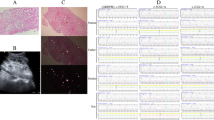Abstract
Infantile primary hyperoxaluria type 1 (PH1) is the most devastating primary hyperoxaluria (PH) subtype as it leads to early end-stage kidney disease (ESKD) associated with high mortality. We report a case of a three-month-old female Chinese infant who was diagnosed with PH1 by renal biopsy and genetic studies. She carried two heterozygous mutations in the alanine-glyoxylate and serine pyruvate aminotransferase (AGXT) gene, one of which has never been previously reported. The patient had multiple organ failures caused by kidney failure, which was improved by extracorporeal membrane oxygenation and continuous renal replacement therapy. However, her primary disease responded poorly to conservative treatment. Fortunately, after waiting for four months, the patient underwent a successful combined liver-kidney transplantation and has progressed well so far. This case highlights the importance of suspecting PH in infant patients with ESKD of uncertain etiology, as early initiation of therapy prevents poor outcomes.


Similar content being viewed by others
References
van Woerden CS, Groothoff JW, Wanders RJ, Davin JC, Wijburg FA. Primary hyperoxaluria type 1 in the Netherlands: Prevalence and outcome. Nephrol Dial Transplant. 2003;18:273–9.
Cochat P, Rumsby G. Primary hyperoxaluria. N Engl J Med. 2013;369:649–58.
Hopp K, Cogal AG, Bergstralh EJ, et al. Phenotype-Genotype correlations and estimated carrier frequencies of primary hyperoxaluria. J Am Soc Nephrol. 2015;26:2559–70.
Jellouli M, Ferjani M, Abidi K, et al. Primary hyperoxaluria in infants. Saudi J Kidney Dis Transpl. 2016;27:526–32.
Cochat P, Hulton SA, Acquaviva C, et al. Primary hyperoxaluria Type 1: Indications for screening and guidance for diagnosis and treatment. Nephrol Dial Transplant. 2012;27:1729–36.
Cochat P, Deloraine A, Rotily M, Olive F, Liponski I, Deries N. Epidemiology of primary hyperoxaluria type 1. Societe de Nephrologie and the Societe de Nephrologie Pediatrique. Nephrol Dial Transplant. 1995;8:3–7.
Harambat J, Fargue S, Acquaviva C, et al. Genotype-phenotype correlation in primary hyperoxaluria type 1: The p.Gly170Arg AGXT mutation is associated with a better outcome. Kidney Int. 2010;77:443–9.
Grenda R, Kalicinski P. Combined and sequential liver-kidney transplantation in children. Pediatr Nephrol. 2018;33:2227–37.
Amoroso A, Pirulli D, Puzzer D, et al. Gene symbol: AGXT disease: primary hyperoxaluria type I. Hum Genet. 1999;104:441.
Monico CG, Rossetti S, Olson JB, Milliner DS. Pyridoxine effect in type I primary hyperoxaluria is associated with the most common mutant allele. Kidney Int. 2005;67:1704–9.
Plumb TJ, Swee ML, Fillaus JA. Nocturnal home hemodialysis for a patient with type 1 hyperoxaluria. Am J Kidney Dis. 2013;62:1155–9.
Ranawaka R, Dayasiri K, Gamage M. Combined liver and kidney transplantation in children and long-term outcome. World J Transpl. 2020;10:283–90.
Lee E, Ramos-Gonzalez G, Rodig N, Elisofon S, Vakili K, Kim HB. Bilateral native nephrectomy to reduce oxalate stores in children at the time of combined liver-kidney transplantation for primary hyperoxaluria type 1. Pediatr Nephrol. 2018;33:881–7.
Villani V, Gupta N, Elias N, et al. Bilateral native nephrectomy reduces systemic oxalate level after combined liver-kidney transplant: A case report. Pediatr Transplant. 2017. https://doi.org/10.1111/petr.12901.
Talati JJ, Hulton SA, Garrelfs SF, et al. Primary hyperoxaluria in populations of Pakistan origin: Results from a literature review and two major registries. Urolithiasis. 2018;46:187–95.
Khorsandi SE, Samyn M, Hassan A, et al. An institutional experience of pre-emptive liver transplantation for pediatric primary hyperoxaluria type 1. Pediatr Transplant. 2016;20:523–9.
Devresse A, Cochat P, Godefroid N, Kanaan N. Transplantation for primary hyperoxaluria type 1: Designing new strategies in the era of promising therapeutic perspectives. Kidney Int Rep. 2020;5:2136–45.
Garrelfs SF, Frishberg Y, Hulton SA, et al. Lumasiran, an RNAi Therapeutic for Primary Hyperoxaluria Type 1. N Engl J Med. 2021;384:1216–26.
Sas DJ, Magen D, Hayes W, et al. Phase 3 trial of lumasiran for primary hyperoxaluria type 1: A new RNAi therapeutic in infants and young children. Genet Med. 2022;24:654–62.
Setten RL, Rossi JJ, Han SP. The current state and future directions of RNAi-based therapeutics. Nat Rev Drug Discov. 2019;18:421–46.
Metry EL, van Dijk L, Peters-Sengers H, et al. Transplantation outcomes in patients with primary hyperoxaluria: A systematic review. Pediatr Nephrol. 2021;36:2217–26.
Author information
Authors and Affiliations
Corresponding author
Ethics declarations
Conflict of interest
The authors declare that they have no conflict of interests.
Informed consent
Written informed consent was taken from parents for publication.
Human and animal rights
This article does not describe any studies with human participants or animals performed by any of the authors.
Additional information
Publisher's Note
Springer Nature remains neutral with regard to jurisdictional claims in published maps and institutional affiliations.
About this article
Cite this article
Ni, T., Sun, Z. & Zhao, F. A case report of invasive infantile primary hyperoxaluria type 1 and literature review. CEN Case Rep 12, 159–163 (2023). https://doi.org/10.1007/s13730-022-00740-z
Received:
Accepted:
Published:
Issue Date:
DOI: https://doi.org/10.1007/s13730-022-00740-z




